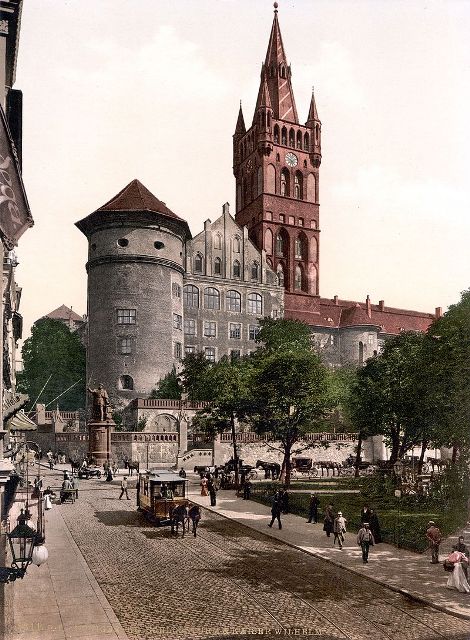Königsberg Castle

Königsberg Castle Photo - Uploaded by Conscious -
Wikipedia - lic. under Attribution

Castle Facts:
Location: Königsberg,Germany,Kaliningrad, Russia.
Built: 1255-1713,
Condition: --
Ownership / Access: --
Notes: The site of the castle was originally an Old Prussian fort known as Tuwangste near the Pregel River at an important waypoint in Prussian territory. Nearby were three Prussian villages, later known as Löbenicht, Sackheim, and Tragheim. After conquering the area in 1255, the Teutonic Knights constructed a provisionary wooden and earthworks fort in place of the Prussian one. By 1257 a new stone Ordensburg castle was being constructed. The castle was greatly enlarged and refortified in several stages during the 16th to 18th centuries.
The fortress, later designated a castle, was the residence of the Grandmasters of the Teutonic Order and later residence for Prussian rulers.
The 1815 Encyclopaedia Britannica refers to "the magnificent palace in which is a hall 83.5 m long and 18 m broad without pillars to support it, and a handsome library. The gothic tower of the castle is very high (100 m) and has 284 steps to the top, from where a great distance can be seen". This extensive building, enclosed in a large quadrangle and situated almost in the center of the city, was formerly a seat of the Teutonic Order. It was altered and enlarged from the 16th to 18th centuries. The west wing contained the Schlorkirche, or palace church, where Frederick I was crowned in 1701 and William I in 1861. The arms emblazoned upon the walls and columns were those of members of the Order of the Black Eagle. Above the church was the 83 m long and 18 m high Moscowiter-Saal, one of the largest halls in the German Reich.
Until the latter part of World War II, the apartments of the Hohenzollerns and the Prussia Museum (north wing, German: Prussia-Sammlung) were open to the public daily. Among other things, the museum accommodated 240,000 exhibits of the Prussian collection, a collection of the Königsberg State and University Library, as well as many paintings by the artist Lovis Corinth. In 1926 Friedrich Lahrs led an excavation of the castle courtyard. During World War II, various pieces of captured Russian art were stored there, possibly including parts of the Amber Room. An extensive collection of provincial archives was also housed there. Also the Blutgericht, a wine selling tavern, was situated within the castle. An image of Hans von Sagan was used as the castle's weathervane.
Following the bombing of Königsberg by the Royal Air Force in the Second World War in 1944, the castle completely burnt down. However, the thick walls were able to withstand both the aerial bombing and Soviet artillery, as well as urban fighting in April 1945, allowing the ruins of the castle to stay standing. The largely demolished Königsberg became part of the Soviet Union and was renamed Kaliningrad in 1946.Kaliningrad was to be rebuilt as a model town on the remains of Königsberg, without reminders of the German past left standing. Leonid Brezhnev consequently ordered that the remains of the castle be disposed of so they would no longer stand as a reminder of "Prussian militarism." Despite protests from students and intellectuals from Kaliningrad, the ruins of the castle were blown up on Brezhnev's personal orders in 1968. However, the ruins of the nearby Königsberg Cathedral, which included the tomb of Immanuel Kant, were left standing, and in the late 1990s and early years of the 21st century were rebuilt and restored.
Königsberg Castle Links:
Königsberg Castle On Wikipedia



